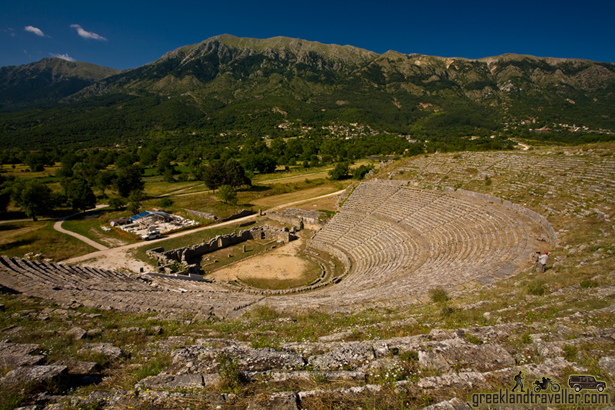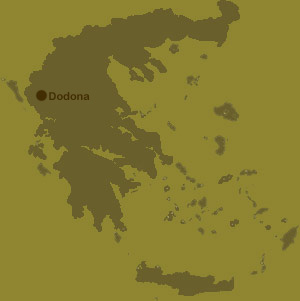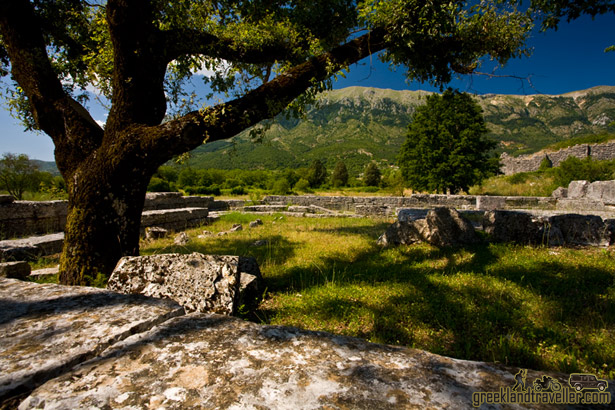Dodona: The oldest oracle of Ancient Greece
 Dodona held the crown among the most holy sites of the prehistoric era as it was in its territory that operated, for more than 2.000 years, the oldest oracle of the Helladic land(Ancient Greece). Originally dedicated to the most ancient deity, the Great Mother Goddess, the oracle was later dedicated to Zeus of Dodona until it finally ceased to operate when Christianity became the prevalent religion. It was then that a profane hand was raised to cut down the holiest of trees, the sacred oak, through the whisper of its leaves the priests interpreted the messages of the gods to the mortal men.
Dodona held the crown among the most holy sites of the prehistoric era as it was in its territory that operated, for more than 2.000 years, the oldest oracle of the Helladic land(Ancient Greece). Originally dedicated to the most ancient deity, the Great Mother Goddess, the oracle was later dedicated to Zeus of Dodona until it finally ceased to operate when Christianity became the prevalent religion. It was then that a profane hand was raised to cut down the holiest of trees, the sacred oak, through the whisper of its leaves the priests interpreted the messages of the gods to the mortal men.
The outdoor sanctuary was focused around the holy oak tree, as we can read in the Homeric Epics: Achilles went there to request the advise of Zeus of Dodona while in the story of the Argonauts we learn that the piece of wood on the bow of the legendary ship ‘Argo’ came from Dodona and thus it had magic properties. According to Herodotus, the story of the foundation of the oracle goes thus: a black pigeon crossed the skies all the way from the Thebes of Egypt to land on the branch of the holly oak. The wise man from Halicarnassus also mentions another version of the story in which the pigeon is a young Egyptian priestess who was taken to Dodona by Phoenician merchants. Simultaneously, another young priestess was taken to Libya where she founded the soon to be very famous oracle of Ammon-Zeus. According to the sources of Herodotus, these two young women were the first to introduce the art of divination in the countries they ended up in.
According to the archaeological evidence now, we know that the oracle was dedicated to the Great Mother Goddess during the 3rd millennium BC. The cult of Zeus was introduced in the 2nd millennium BC by a Thesprotian tribe and it soon became prevalent. It has come down to us that the oracles were delivered verbally after the interpretation of the rustling of the foliage of the holly oak; also it could be ‘read’ through the croak sounds of the pigeons or the sounds of the brass boilers that surrounded the sacred tree. As for those asking the divine advice, they had to curve their queries on lead sheets.
The oracle reached the apogee of its influence during the reign of Pyrrhus, the king of Epirus. It was during his reign that several great works took place in the area of Dodona, like the grand temple of Zeus, the temple to Hercules as well as the largest theatre of the Helladic territory of that time. Every four years, in the theatre of Dodona would take place the great celebrations in honour of Zeus of the Temple (Naia). That theatre was to be destroyed and rebuilt at least twice since, going through several modifications.
The curtain for the famous both in Greece as well in all the ancient world oracle came when Christianity became the prevalent religion. In the 4th century AD, the emperor Theodosius banned the worship of the twelve ancient gods and soon the holy oak was cut down by the profane hand of man from Illyria. Dodona was soon abandoned and it did not take long for the mud from the slopes of the mountain Tomaro covered up what was for thousands of years the most famous of oracles.
In the years 1875-1878 the huge ancient theatre, which had been transformed into an arena during the Roman Era, was rediscovered. Its size provokes awe even today as it had space for about 17.000 people – an impressive size if one considers that the theatre of Epidaurus and the Odeon of Herodus Atticus together have the capacity of ‘only’ 10.000 people, while the Wembley Arena in London has a capacity of 12.500 spectators.
Other very important monuments in the premises of ancient Dodona is the Sacred House (Temple of Zeus) which is the oldest building there, dated to the 4th century BC, the Prytaneion where the priests of Zeus were housed, the Vouleutirion, the temples of Hercules, Themis (the goddess of justice), Dione (the wife of Zeus), as well as the Stadium which is not yet fully excavated and is dated to the 3rd century BC.
As for the archaeological findings from Dodona, many of them can be found in the Archaeological Museum of Ioannina while the most important artefacts are in the National Archaeological Museum in Athens (as well as in museums in France and Germany after being sold by looters).
Article was written by Calliope Alahouzou
Location
 Ancient Dodona is located in the region of Epirus specifically in the municipality of Dodoni. It is 25 minutes drive from the city of Ioannina following the Egnatia Odos towards Igoumenitsa. Once you get on exit “Dodona”, follow the obvious signs for the site.
Ancient Dodona is located in the region of Epirus specifically in the municipality of Dodoni. It is 25 minutes drive from the city of Ioannina following the Egnatia Odos towards Igoumenitsa. Once you get on exit “Dodona”, follow the obvious signs for the site.





